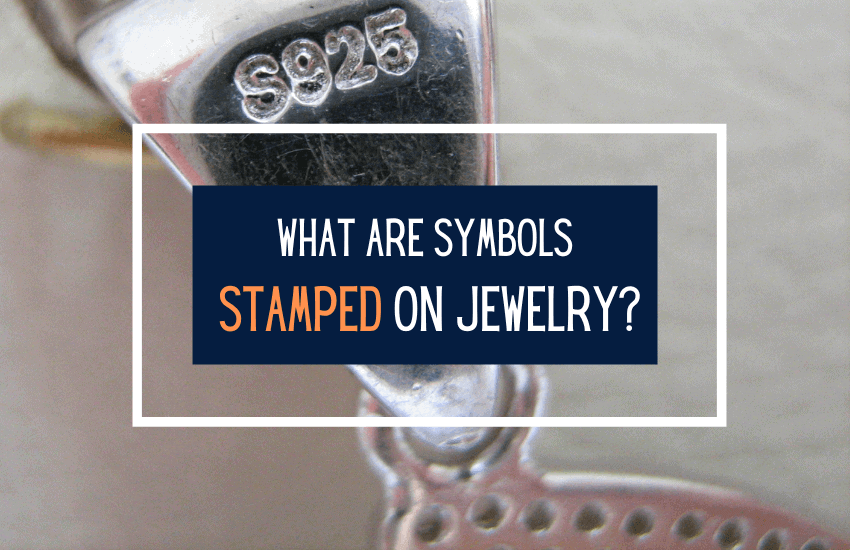
Table of Contents
If you’ve ever bought or sold jewelry or precious metals, you may have seen small symbols or marks stamped onto the metal. These are usually stamped in very fine print on the inner side of jewelry pieces, but they can be easily identified under a magnifying glass.
These symbols are important as they offer information about the piece of jewelry. In this article, we’ll be taking a close look at the various symbols stamped on jewelry and the meanings behind them.
Why Stamp Symbols on Jewelry?
The symbols you see on jewelry are identification markers for each piece of jewelry or precious metal. They indicate where and when the piece was made, what is in its composition, and what assay office (testing/certification office) has confirmed and guaranteed its quality.
These symbols are not “replaced” or made unnecessary by the paper certificates jewelers usually also provide for their jewelry pieces. Instead, they’re highly important, since they’re the main certification for each piece of jewelry. They’re permanent stamps that cannot be erased and will always be a part of the jewelry.
If you want to sell a piece of heirloom jewelry and you don’t know its exact origin, metal composition and/or the manufacturer – a jeweler will easily be able to give you this information just by looking at the identification stamps under a magnifying glass.
What are the Main Marks Stamped on Jewelry?
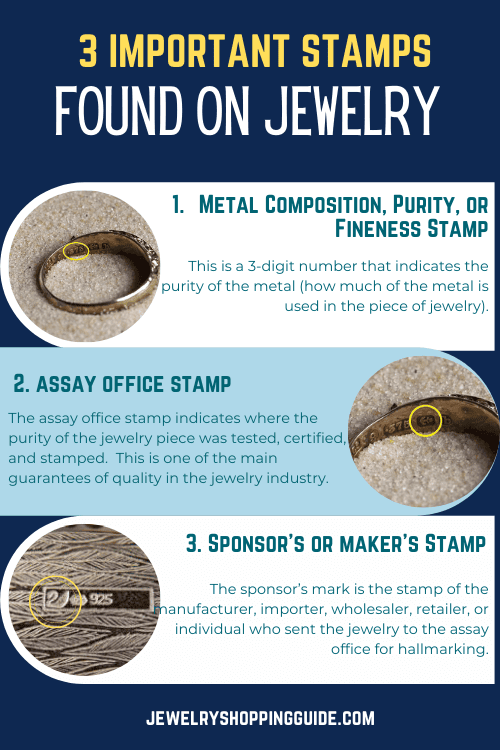
The standards of jewelry and precious metals have changed over the years and different marks, or stamps have been introduced, changed, or removed from time to time. That’s why, if you look at older jewelry pieces, you’ll most likely find marks that are no longer in use today.
According to today’s standards, there are only three necessary or compulsory marks every piece of jewelry must have – the purity or metal composition stamp, the Assay Office stamp, and the manufacturer’s stamp. In addition to these, there are others, which we’ll mention below as well.
The three main marks are as follows:
1. The Metal Composition, Purity, or Fineness Stamp
Usually referred to as just the purity mark, purity stamp, or hallmark, this is a 3-digit number that indicates the purity of the metal (how much of the metal is actually used in the piece of jewelry).
- Why Purity?
Most jewelry metals are not 100% pure since they’re combined with other metals. That’s because the goal of the metal isn’t just to be precious but to also be practical – to be easy to shape and resize, comfortable enough to wear and durable enough to last a lifetime.
For example, both gold and silver are highly valued metals, but they’re also extremely soft in their natural state. Due to this softness, pure gold or pure silver is just not practical to use for jewelry. These metals are mixed (or alloyed) with other metals such as copper, nickel, zinc to increase their strength and durability. The purity mark on the jewelry piece indicates how pure a piece of metal is by a factor of a thousand.
- What Does the Purity Mark Indicate?
A gold ring with a “750” purity mark is actually made of 75% (or 750 thousandths) gold and 25% of copper, nickel, zinc or a different metal. The purity mark does not indicate the percentage of the other metal used in its composition. Instead, it tells us how much gold there actually is in the piece.
A “750” purity marks means 18 karats (the unit of measurement of fineness) which is a lot easier to calculate. A piece of 24K gold is 100% pure gold, so a mark of “750” would mean that 75% of pure gold is present in the piece. That’s equivalent to 18 karats (18 being 75% of 24K).
- Types of Purity Stamps
Most stamps have a specific shape, which differs according to the type of metal. Inside the shape, you’ll see a number which is known as the ‘millesimal stamp number’. This number indicates the purity level of the metal in the jewelry piece.
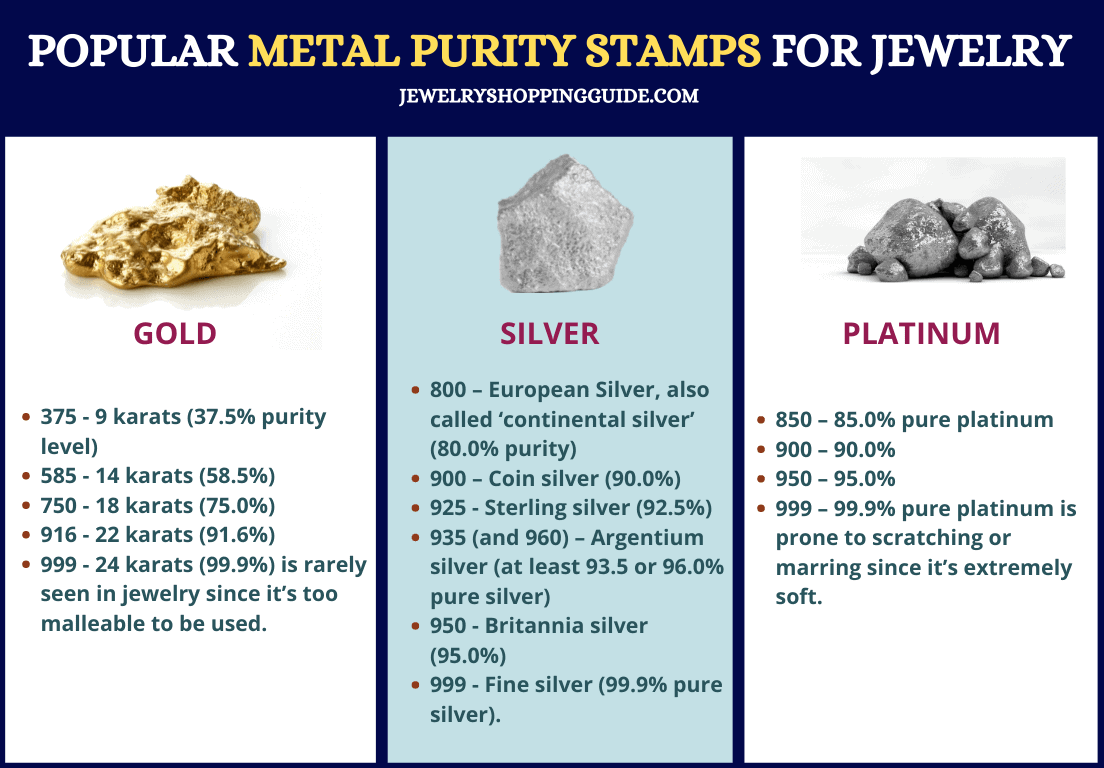
Here’s a closer look at the common purity stamps for the precious metals gold, silver, platinum and palladium, which are commonly used in jewelry:
- Gold Purity Stamps
Gold purity stamps have been used for many decades to identify the type and purity level of gold in the given piece of jewelry. If the stamp is shaped like a rectangle with the four corners truncated, this typically means that the item is gold.
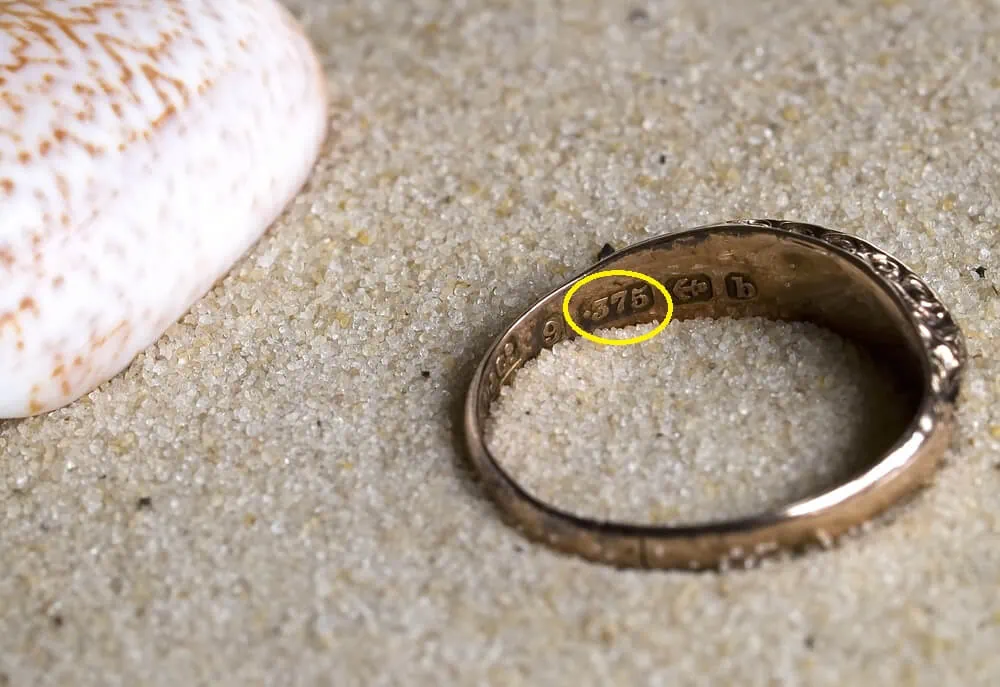
Here are the gold purity stamps you’re most likely to see in jewelry:
- 375 – 9 karats (37.5% purity level)
- 585 – 14 karats (58.5%)
- 750 – 18 karats (75.0%)
- 916 – 22 karats (91.6%)
- 999 – 24 karats (99.9%) is rarely seen in jewelry since it’s too malleable to be used.
- Silver Purity Marks
Silver jewelry can be identified by an oval-shaped stamp. These are the most common silver purity marks found on jewelry:
- 800 – European Silver, also called ‘continental silver’ (80.0% purity)
- 900 – Coin silver (90.0% purity)
- 925 – Sterling silver (92.5% purity level)
- 935 (and 960) – Argentium silver (at least 93.5 or 96.0% pure silver)
- 950 – Britannia silver (95.0%). This type of silver qualifies as sterling but is slightly softer than 925 sterling silver.
- 999 – Fine silver (99.9% pure silver). Like gold, fine silver jewelry is quite hard to come by since the metal is too soft for use.
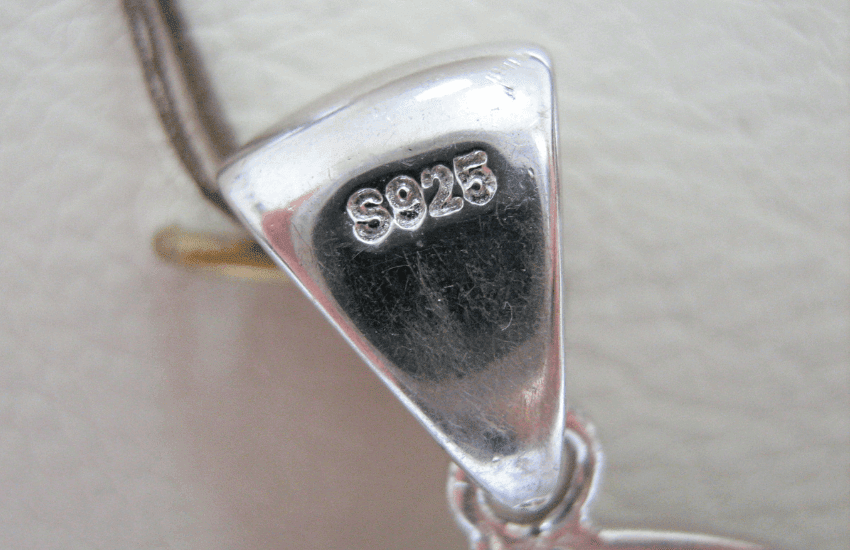
- Common Platinum Purity Marks
Platinum jewelry typically has a high level of purity which is what makes it a hypoallergenic metal and safe for people with sensitive skin. A stamp in the shape of a house indicates that the jewelry piece is made of platinum. Platinum jewelry usually come with the following stamps:
- 850 – 85.0% pure platinum
- 900 – 90.0%
- 950 – 95.0%
- 999 – 99.9% pure platinum is prone to scratching or marring since it’s extremely soft.
- Common Palladium Purity Marks
In the past, all palladium jewelry pieces were marked with a trapezium-shaped stamp. However, new palladium jewelry (as of 2010), is stamped with three ovals, one around each number. There are several purity levels of palladium but these are some of the most common:
- 500 – 50% pure palladium. This is the lowest purity level found in palladium jewelry.
- 950 – 95.0%
- 999 – 99.9% purity level
2. Assay Office Stamp
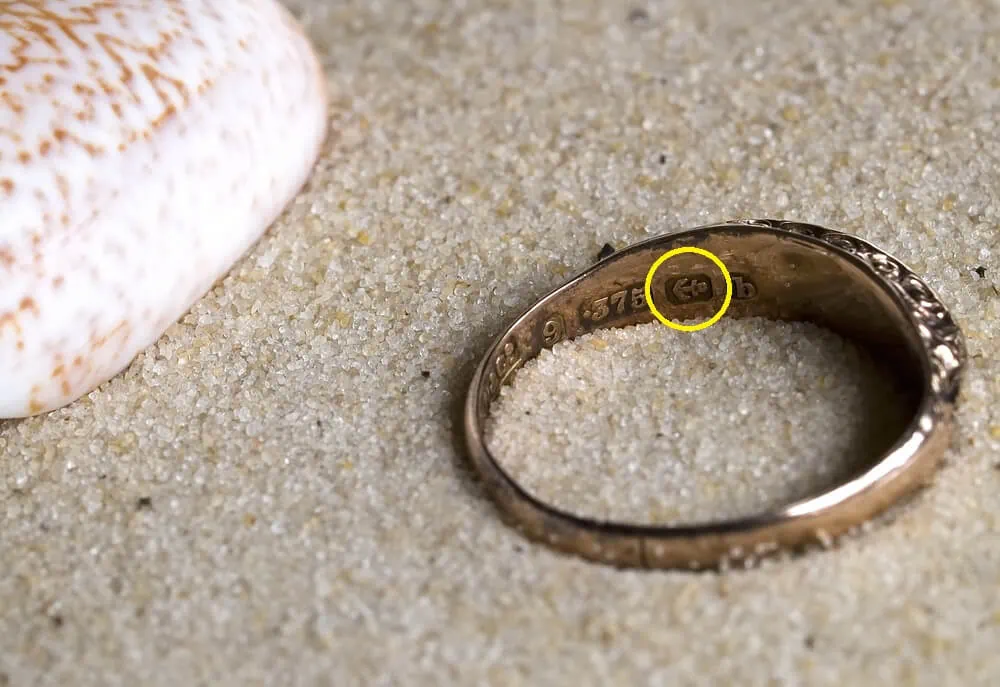
The assay office stamp indicates where the purity of the jewelry piece was tested, certified, and stamped. This is one of the main guarantees of quality in the jewelry industry – if the assay mark is of a reputable assay office, you can rest assured that the purity and quality indicated by the stamp is accurate.
Every assay office has its own, easily distinguishable symbol. For example, the Birmingham Assay Office is an anchor, the London office mark is the head of a big cat, the Sheffield mark is a white rose, and the Edinburgh office mark is a castle.
These are the four UK assay offices that are still open to this day, but in the past there were many more in York, Newcastle, Norwich, Glasgow, Exeter, and Chester. Many other countries have their own assay offices and most of them recognize each other as reputable assay offices.
The U.S. only began manufacturing precious metals in the 1840s, which is why most older jewelry items found in the U.S. are stamped with European purity marks. It was only in 1906 that certain regulations around the process of hallmarking jewelry went into effect.
3. Sponsor’s or Manufacturer’s Stamp
The sponsor’s mark (also known as the ‘maker’s mark) is the stamp of the manufacturer, importer, wholesaler, retailer, or individual who owned the piece of jewelry and who sent it to the assay office for hallmarking. This mark can belong to anyone from the mining company who first mined and smelted the metal to the jeweler who crafted it into jewelry.
Additional or Optional Stamps
Old jewelry pieces (or even some contemporary ones) can have much more than just the three symbols stamped on them. There were many other marks used which have simply been deemed unnecessary over the years so they’re not always present on jewelry. However, they’re still very informative so it’s worth paying attention to them, especially when it comes to older heirloom jewelry.
Here are some additional or optional stamps that you may come across when examining older pieces of jewelry:
1. Date Letters – The Year of the Hallmarking Stamp
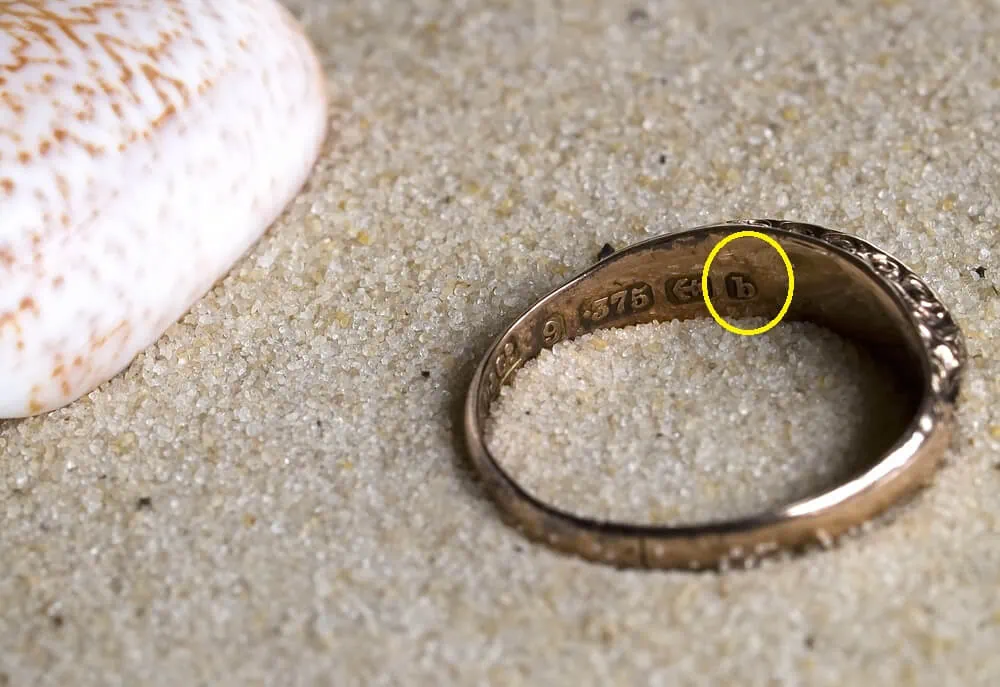
Date letters tell you in which year the item’s purity was tested, and not the year the item was manufactured, like most people tend to think.
The date letter used to be the 4th mandatory stamp on all jewelry pieces but in 1998, they were regarded as unnecessary. Although jewelers stopped stamping their pieces with date letters, there are some who still continue to include them. If you see a jewelry piece without a date letter stamped on it, you’ll at least know that it was made after 1998.
It’s worth noting that dates in jewelry are marked with letters instead of numbers, the main reason being to save space on the jewelry piece. Each year had a specific letter of the alphabet assigned to it and every 25 years, the font was modified so that the same letter could be used again without creating any confusion.
Another interesting quirk of this system is that in every 25-year cycle, either one of the three letters I, J and L are omitted to avoid confusion. This is why every cycle lasts 25 years instead of 26.
2. Traditional Standard Stamp
These stamps were used in conjunction with purity marks as the traditional stamp indicated the type of base metal in the jewelry, and the purity mark indicated its purity.
This marking indicated the basic metal of the jewelry piece. For example, the traditional mark for gold was a crown, for sterling silver a lion, for Brittania silver the figure of Brittania, and for palladium a Greco-Roman helmet.
Nowadays, the traditional mark isn’t compulsory as jewelers can easily tell the type of base metal they’re looking at without needing the stamp.
3. Commemorative Stamps
Commemorative stamps are used on special types of jewelry that are created for a particular event that needs to be commemorated, such as coronations, anniversaries or the turn of a millennium, to name a few. Today, it’s extremely rare to see such a mark on “standard” jewelry sold by most retailers.
4. Jeweler’s Stamp
Some famous and reputed jewelers are sometimes allowed to leave their own marks on a piece of jewelry, next to the sponsor’s stamp. If the jeweler is also the owner of the piece then his or her stamp would also be the sponsor’s stamp, but if not, the piece can have both a sponsor’s and a jeweler’s stamp on it.
Wrapping Up
The next time you look closely at a piece of jewelry, you’ll be able to tell a lot about it now that you know everything you need to about the many different types of jewelry stamps. Having a clear understanding about these stamps is useful since you’re less likely to be scammed when you know what you’re looking at. It’s the best way to avoid buying imitation jewelry and making sure that the piece you’re buying is genuine.









